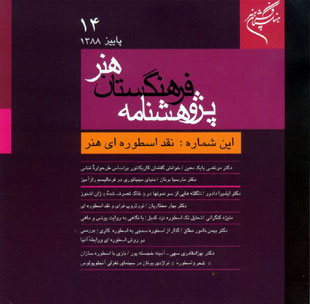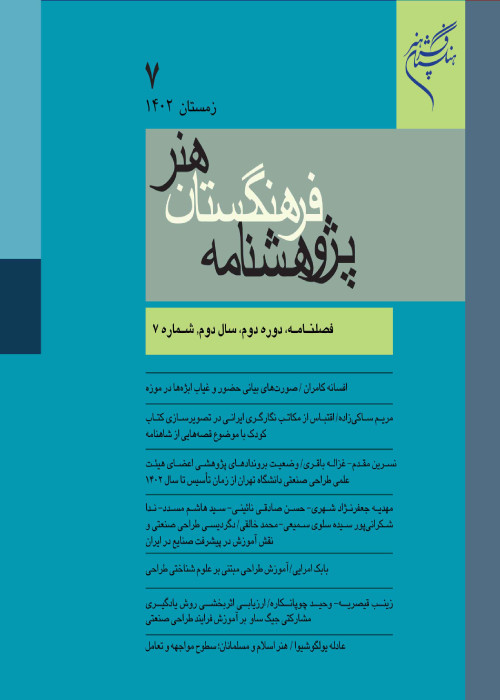فهرست مطالب

پژوهشنامه فرهنگستان هنر
پیاپی 14 (پاییز 1388)
- نقد اسطوره ای هنر
- 144 صفحه،
- تاریخ انتشار: 1388/09/15
- تعداد عناوین: 9
-
صفحه 5
- بخش اول:اصول و مبانی نقد و پژوهش هنری
- بخش دوم: نقدنامه
-
صفحه 58
-
Page 7
Schémata tensif is one of the numerous schemata on the subject of discourse. The schemata consists of two different aspects which could be assumed as lining on axis y and axis x. The x axis (vertical line) is proportionate to the amount of tension and emotion and deals with qualitative, intrinsic and emotional values whereas the y axis (horizontal line) refers to the cognitive expanse and deals with quantitative and numerical traits as well as spatiotemporal expanse. Within this paper, based on the increase/decrease in co-vectoring/anti-vectoring tension and cognitive expanse, four different possible schémata tensifs are defined -- namely, falling emotional-tensif schemata, rising emotional-tensif schemata, two-dimensional rising co-vectoring schemata, and two-dimensional falling co-vectoring schemata. Then it will try to find out in what schémata tensif the caricature discourse would be placed. Having well defined the caricature discourse and compared its function with that of dream, the paper will be carried with examples to show that the caricature discourse could be read based on falling schémata tensif
Keywords: Schémata Tensifs, Discourse Rupture, Discourse Union, Caricature, Dream -
Page 19
Throughout the twentieth century, prominent critics drew on formalist discourses in order to frame compelling narratives on the complex relations between embodiment, gender, metaphysics, and psychoanalytic theories in modernist aesthetics. A particularly suggestive example can be found in the critic and curator James Johnson Sweeney’s interactions with the sculptor Alexander Calder. Sweeney often characterized Calder’s art as the product of a visionary child who engaged in the paradox of Serious play. As he formulated fantastic, alternative worlds populated by miniature and gigantic creatures. In so doing, Sweeney promoted a visionary formalist approach that drew on Calder’s art to present a larger, mystical vision of the expansive possibilities contained within the microcosmic world of the modern museum
Keywords: Formalism, Calder, Sweeney, Mysterious, Modernism Aesthetics -
Page 44
Jung, psycologist and theorist of collective unconscious, believed that in analysing the psychic we could find the mythological motifs present in the unconscious of each individual. These motifs should be discovered through a second psychic system, as it is not developed individually but is inherited and has eternal and universal meanings. Archetypes are the most complete and precise form of these motifs which incarnate in aesthetic and religious symbols. In this paper we will try, through a new interpretation of The Occupation of the Ground, by Jean Echenoz, and by considering Jung’s theory of collective unconscious, to explore some archetypal unnoticed in the hidden layers of the story in order to be an answer to propounded questions.
Keywords: Archetype, Image, Unnoticed, Collective-Unconscious, Ruin -
Page 58
The relationship between myth and literature has always attracted the attention of scholars, most of which have even regarded literature as a subcategory of myth. Meanwhile, Northrop Frye, a western literary critic, was the first to establish the relationship between myth and literature as a systematic framework within the body of literary criticism. This paper attempts to have a glance at the New Criticism and the position of Frye within this school, and then focuses on his experiments with the myth-literature relationship. Before dealing with his method, we should have a brief look at his experimental method of recourse to the Holy Bible and then its synthesis with the archetypal approach that is, on the one hand, inspired by Frazer’s Comparative Anthropology and, on the other hand, is impressed by Jungian Psychology. It will then discuss two key concepts of displacement and condensation in Frye’s literary criticism theory where they are applied to explain the growth and evolution of literary structures from the heart of myth.
Keywords: Myth, Literature, Literary Criticism, Northrop Frye, Displacement, Condensation -
Page 74
Joseph Campbell is one of the most significant contemporary theoreticians in the field of myths. Campbell presented his theory of monomyth according to the motifs and common mythic themes found in different cultures, and he discusses that myths follow uniform archetypes although they undertake transformation as they pass through different cultures and take newer forms. This paper sets to study the hero as the most important universal archetype and his transformation strand in the light of Campbell’s theory of monomyth; then it presents a mythological reading of the narrative of Jonah and his captivity in the mouth of a large fish based on the version of Jame’-al-Tavarikh and Campbell’s approach in order to achieve a deeper understanding of the transformation strand of the hero in this narrative.
Keywords: Joseph Campbell, Archetype, Monomyth, Hero, Jame’-al-tavarikh.Download -
Page 92
Mythology nowadays involves a large number of histories, theories and criticism. Mythological approaches and theories have been evolving in line with time and different paradigms so much so that some belong to Pre-Structuralist, some to Structuralist, and others to Post-Structuralist period. In this article, we tend to make a survey of two mythological approaches current in the 70’s and 80’s which were later appealing to myth-scholars like Gilbert Durand. The approached called mythocritique and mythanalyse are the most significant mythological approaches that represent Structuralist and PostStructuralist studies of myth respectively. The present paper begins with a brief introduction to these two approaches and then deals with the causes of shift from mythocritique to mythanalyse and finally makes a reading of the novel Aurélia based on the mythocritique approach.
Keywords: Myth, Criticism, Art, Mythocritique, Mythanalyse -
Page 109
Theo Angelopoulos is regarded as the main figure of the New Greek Cinema. The wide range of allusions in his films to Greek mythology and tragedy indicates his profound connection with the historical and literary reservoir of his native land. This article explores the poetic essence of Greek tragedy in his films, focusing on Ulysses’ Gaze (1995), and The Weeping Meadow (2004). The authors study the structure and themes of these two films and the poetic symbols and motifs such as fluidity, river and source as well as some other poetic elements of Greek tragedy, to argue that Angelopoulos stands as a latter-day Greek tragic poet who uses Greek mythology for deconstructive purposes in today’s world
Keywords: Greek Tragedy, Greek Mythology, Theo Angelopoulos, Ulysses’ Gaze, The Weeping Meadow, Poetry


